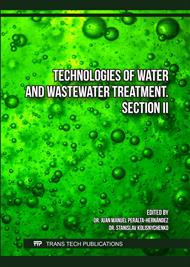[1]
E.S. Pikalov, O.G. Selivanov, V.Yu., Chukhlanov, M.A. Sukharnikov. The use of regional waste in the production of wall ceramic products, Vladimir State University named after Alexander Grigorievich and Nikolai, Ecology and Industry of Russia. 6 (21) (2017) 24-29.
DOI: 10.18287/1613-0073-2018-2210-149-155
Google Scholar
[2]
M.A. Sukharnikova, E.S. Pikalova. Investigation of the possibility of producing ceramic bricks based on low-plastic clay with the addition of electroplating sludge, Successes of modern science. 10 (2015) 44-47.
Google Scholar
[3]
S.V. Svergusova, Zh.A. Sapronova, A.V. Svyatchenko. Technology for obtaining iron-containing coagulant from steelmaking production waste for storm water purification, Bulletin of BSTU named after V.G. Shoukhov. 12 (2016) 160-164.
Google Scholar
[4]
I.V. Starostin, M.M, Simonov, L.V. Denisov. The use of ferrovanadium production sludge wastes in claydite glavel technology, Solid State Phenomena. 265 (2017) 501-506.
DOI: 10.4028/www.scientific.net/ssp.265.501
Google Scholar
[5]
R.Sh. Valeev, I.G. Shayhiev. Disposal of sludge waste heat power plants in the production of building materials, Ecology and Industry of Russia. 2 (2010) 28-29.
Google Scholar
[6]
L.N. Olshanskaya, E.N. Lazareva, V.V. Egorov, A.A. Sorokin. The use of sludge electroplating, in the manufacture of consumer goods, Polzunovsky messenger.4-2 (2011) 203-206.
Google Scholar
[7]
R.Sh. Valeev, I.G. Shaikhiev. Recuperative technology of utilization of sludge waste water treatment in building materials using plasticizer C-3, Vestnik of Kazan State Technological University.13 (2011) 41-45.
Google Scholar
[8]
S.V. Sverguzova, Z.A. Sapronova, I.G. Shaykhiev, R.O. Fetisov, A.V. Shamshurov. Water treatment sludge as a pore-forming additive to ceramic mixtures, Vestnik of Kazan State Technological University. 7 (15) (2012) 137-139.
Google Scholar
[9]
S.V. Sverguzova, Zh.A. Sapronova, I.V. Starostina. Disposal of Synthetic Surfactants Containing Wastewater Treatment Sludge in the Ceramic Brick Production, Procedia Engineering 150 (2016) 1610-1616.
DOI: 10.1016/j.proeng.2016.07.138
Google Scholar
[10]
S. Suzuki, M. Tanaka, T. Kaneko. Glass-ceramic from sewage sludge ash, journal of materials science. 32 (1997) 1775—1779.
Google Scholar
[11]
R. Sokolar, S.Grygarova. Utilization of waste quarry washing sludge for the production of drypressed ceramic bodies. Journal of the Ceramic Society of Japan. 121 (1) (2013)120-122.
DOI: 10.2109/jcersj2.121.120
Google Scholar
[12]
H. Hamaiedh. Reuse of Marble Sludge Slime in Ceramic Industry, Jordan Journal of Civil Engineering. 3 (4) (2010) 264-271.
Google Scholar
[13]
N. Hal, T. Yeml. Study on reuse of heavy metal rich sludge in ceramic pigment and construction material production, VNU Journal of Science, Natural Sciences and Technology 24 (2008) 280-286.
Google Scholar
[14]
Reference Documenton Best Available Techniques in the Ceramic Manufacturing Industry. 8 (2007) 225.
Google Scholar
[15]
S.A. Ahmed, M.E. Metwally, S.E. Zakey. Assessment of Ceramic Tiles Sludge as a Brick Manufacturing, Material International Journal of Engineering Research &Technology. 10 (5) 376-381.
Google Scholar
[16]
S.V. Sverguzova, I.V. Starostina, Zh.A. Sapronova. Disposal of synthetic Surfactants Containing Wastewater Treatment Sludge in the Ceramic Brick Production, Procedia Engineering 150 (2016) 1610-1616.
DOI: 10.1016/j.proeng.2016.07.138
Google Scholar
[17]
O Kizinievič, V Kizinievič. Utilization of drinking water treatment sludge for the manufacturing of ceramic products, IOP Conf. Series: Materials Science and Engineering. 251 (2017) 012018.
DOI: 10.1088/1757-899x/251/1/012018
Google Scholar



